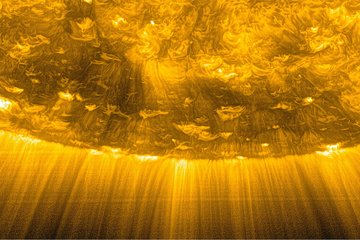All genres
1.
Journal Article
Hydrogen in magnetite from asteroid Ryugu. Meteoritics and Planetary Science 59, pp. 2058 - 2072 (2024)
2.
Journal Article
Isotopic evidence for a common parent body of IIG and IIAB iron meteorites. Geochimica et Cosmochimica Acta 382, pp. 118 - 127 (2024)
3.
Journal Article
Curation protocol of Phobos sample returned by Martian Moons eXploration. Meteoritics and Planetary Science 59, pp. 321 - 337 (2024)
4.
Journal Article
Hf-W isotope systematics of enstatite chondrites: Parent body chronology and origin of Hf-W fractionations among chondritic meteorites. Earth and Planetary Science Letters 626, p. 118518 (2024)
5.
Journal Article
Pervasive aqueous alteration in the early Solar System revealed by potassium isotopic variations in Ryugu samples and carbonaceous chondrites. Icarus 409, p. 115884 (2024)
6.
Journal Article
Condensate evolution in the solar nebula inferred from combined Cr, Ti, and O isotope analyses of amoeboid olivine aggregates. Earth and Planetary Science Letters 627, p. 118567 (2024)
7.
Journal Article
Tungsten stable isotope composition of the upper continental crust. Geochimica et Cosmochimica Acta 370, pp. 161 - 172 (2024)
8.
Journal Article
Isotopic constraints on genetic relationships among group IIIF iron meteorites, Fitzwater Pass, and the Zinder pallasite. Meteoritics and Planetary Science 59, pp. 778 - 788 (2024)
9.
Journal Article
Pyrrhotites in asteroid 162173 Ryugu: Records of the initial changes on their surfaces with aqueous alteration. GEOCHIMICA ET COSMOCHIMICA ACTA, pp. 172 - 183 (2024)
10.
Journal Article
An inner solar system origin of volatile elements by Mars. Icarus 397, 115519 (2023)
11.
Journal Article
Origin of 182W Anomalies in Ocean Island Basalts. Geochemistry, Geophysics, Geosystems 24, p. e2022GC010688 (2023)
12.
Journal Article
Spurious molybdenum isotope anomalies resulting from non-exponential mass fractionation. Geochemistry (2023)
13.
Journal Article
Carbonate record of temporal change in oxygen fugacity and gaseous species in asteroid Ryugu. Nature Geoscience 16, pp. 675 - 682 (2023)
14.
Journal Article
Origin of Isotopic Diversity among Carbonaceous Chondrites. The Astrophysical Journal 946, p. L34 (2023)
15.
Journal Article
Abundant presolar grains and primordial organics preserved in carbon-rich exogenous clasts in asteroid Ryugu. Science Advances 9, p. eadh1003 (2023)
16.
Journal Article
Isotopic constraints on genetic relationships among group IIIF iron meteorites, Fitzwater Pass, and the Zinder pallasite. Meteoritics & Planetary Science, pp. 1 - 11 (2023)
17.
Journal Article
Hydrogen Isotopic Composition of Hydrous Minerals in Asteroid Ryugu. The Astrophysical Journal Letters 946, p. L43 (2023)
18.
Journal Article
Distribution of s-, r-, and p-process Nuclides in the Early Solar System Inferred from Sr Isotope Anomalies in Meteorites. The Astrophysical Journal 952, p. L25 (2023)
19.
Journal Article
The Oxygen Isotopic Composition of Samples Returned from Asteroid Ryugu with Implications for the Nature of the Parent Planetesimal. The Planetary Science Journal 4, p. 144 (2023)
20.
Journal Article
Age and genetic relationships among CB, CH and CR chondrites. Geochimica et Cosmochimica Acta (2023)










